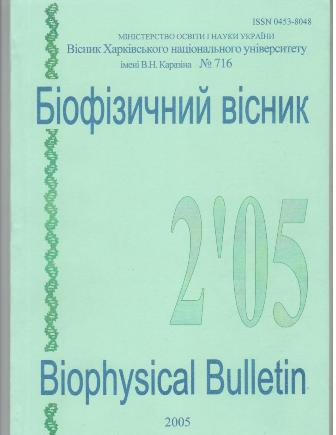N-butanol and N-hexanol effects on anion transport in red blood cells
Abstract
N-butanol and n-hexanol effects on anion transport in human, cheep, and chicken red cells were investigated in the work. Anion transport was measured indirectly by recording changes in extracellular medium pH. Change in pH is known to occur as a result of Cl-/HSO4- exchange by means of anion exchanger: band 3 protein. The constant of the rate of hydrogen ions entering K2 has been calculated in the work. Both n-butanol and n-hexanol reduce the constant of the rate of hydrogen ion entering in red cells of all studied species, which testifies to slowing down the HSO4- transport into a cell in n-alkanol presence. Thus, both n-butanol and n-hexanol may be assumed to interact with band 3 protein in red cells by changing their functional state.
Downloads
References
Ramazanov VV, Nadrid IaO, Oleinik OA, Bondarenko VA. Vliianiie PEG-1500 na sviazyvanie dipiridamola s anionnym kanalom eritrotcitov. Problemy kriobiologii. 2003;4:25-33. (in Russian)
Bisognano JD, Dix JA, Pratar PR, Novak TS, Freedman JC. Proton(or hydroxide) fluxes and the biphasic osmotic response of human red blood cells. J. Gen. Physiol. 1993;102:99-123.
Bruce LJ, Beckmann R, Ribeiro ML, Peters LL, Chasis JA, Delaunay J, et al. A band 3-based macro complex of integral and peripheral proteins in the RBC membrane. Blood. 2003;101:4180-88.
Brahm J. Temperature-dependent changes of chloride transport kinetics in human red cells. J. Gen. Physiol. 1977;70:283-306.
Castranova V, Weise MJ, Hoffman JF. Anion Transport in dog, cat and human red cells. Effects of varying cell volume and Donnan ratio. J.Gen. Physiol. 1979;74:319-34.
Hemmings HCJr, Akabas MH, Goldstein PA, Trudell JR, Orser BA, Harrison NL. Emerging molecular mechanisms of general anesthetic action. Trends Pharmacol. Sci. 2005;26(10):503-10.
Forman SA, Verkman AS, Dix JA, Solomon AK. n-Alkanols and halothane inhibit red cell anion transport and increase band 3 conformational change rate. Biochemistry. 1985;24:4859-66.
Franks NP. Molecular targets underlying general anesthesia. Br J. Pharmacol. 2006;14:72-81.
Makriyannis A, Fesik SW. Effects of anaesthetics on sulphate transport in the red cell. J. Neurosci. Res. 1980;5(1):25-33.
Matei H, Frentescu L, Benga Gh. Comparative studies of the protein composition of red blood cell membranes from eight mammalian species. J. Cell. Mol. Med. 2000;4(4):270-6.
Nouri-Sorkhabi MH, Agar NS, Sullivan DR, Gallagher C, Kuchel PW. Phospholipid composition of erythrocyte membranes and plasma of mammalian blood including Australian marsupials; quantitative 31P NMR analysis detergent. Comp. Biochem. Physiol. 1996;113B(2):221-7.
Romano L, Passow H. Characterization of anion transport system in trout red blood cell. Am. J. Physiol. 1984;246:330-327.
Ellory JC, Young JD,editors. Red cell membranes - a methodological approach. Academic Press. 1982. 369 p.
Tas PW, Kress HG, Koschel K. General anesthetics can competitively interfere with sensitive membrane proteins. Proc. Natl. Acad. Sci. USA. 1987;84(16):5972-5.
Authors who publish with this journal agree to the following terms:
- Authors retain copyright and grant the journal right of first publication with the work simultaneously licensed under a Creative Commons Attribution License that allows others to share the work with an acknowledgement of the work's authorship and initial publication in this journal.
- Authors are able to enter into separate, additional contractual arrangements for the non-exclusive distribution of the journal's published version of the work (e.g., post it to an institutional repository or publish it in a book), with an acknowledgement of its initial publication in this journal.
- Authors are permitted and encouraged to post their work online (e.g., in institutional repositories or on their website) prior to and during the submission process, as it can lead to productive exchanges, as well as earlier and greater citation of published work (See The Effect of Open Access).





